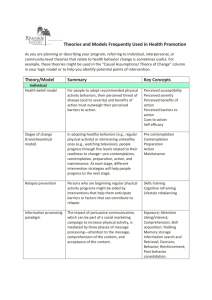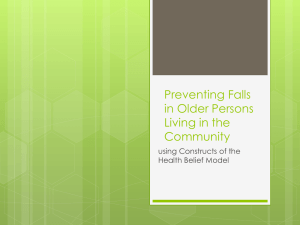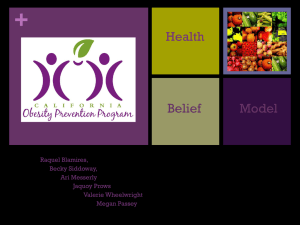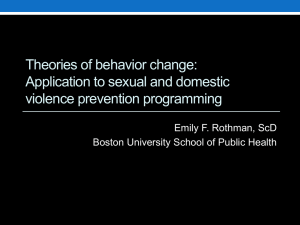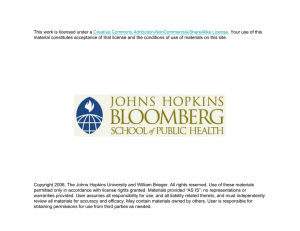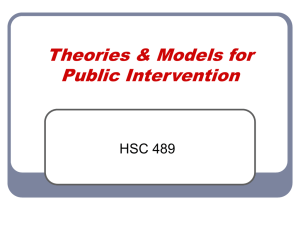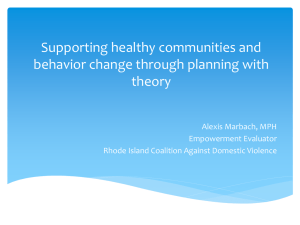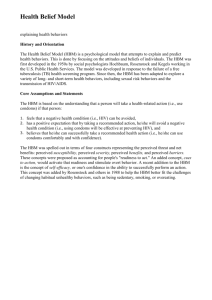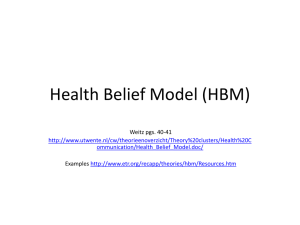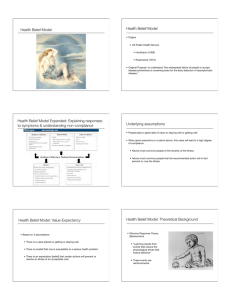categories of health behavior: 1. Preventive health behavior
advertisement
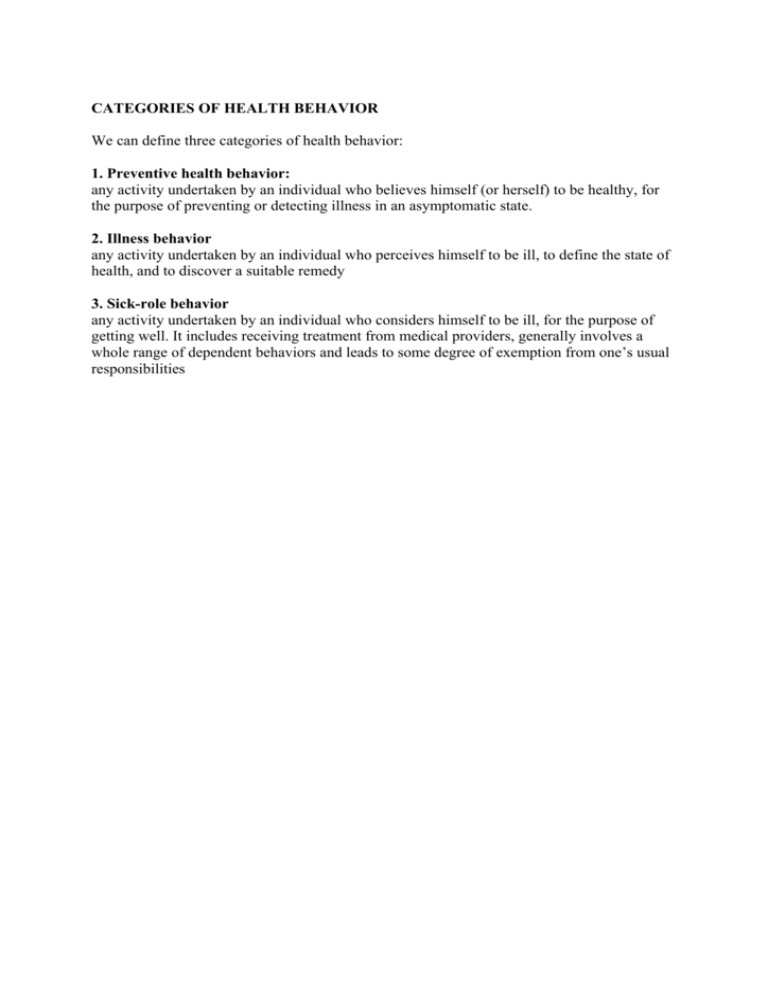
CATEGORIES OF HEALTH BEHAVIOR We can define three categories of health behavior: 1. Preventive health behavior: any activity undertaken by an individual who believes himself (or herself) to be healthy, for the purpose of preventing or detecting illness in an asymptomatic state. 2. Illness behavior any activity undertaken by an individual who perceives himself to be ill, to define the state of health, and to discover a suitable remedy 3. Sick-role behavior any activity undertaken by an individual who considers himself to be ill, for the purpose of getting well. It includes receiving treatment from medical providers, generally involves a whole range of dependent behaviors and leads to some degree of exemption from one’s usual responsibilities HEALTH BELIEF MODEL Constructs Perceived Susceptibility. Perceived susceptibility refers to beliefs about the likelihood of getting a disease or condition. For instance, a woman must believe there is a possibility of getting breast cancer before she will be interested in obtaining a mammogram. Perceived Severity. Feelings about the seriousness of contracting an illness or of leaving it untreated include evaluations of both medical and clinical consequences (for example, death, disability, and pain) and possible social consequences (such as effects of the conditions on work, family life, and social relations). The combination of susceptibility and severity has been labeled as perceived threat. Perceived Benefits. Even if a person perceives personal susceptibility to a serious health condition (perceived threat), whether this perception leads to behavior change will be influenced by the person’s beliefs regarding perceived benefits of the various available actions for reducing the disease threat. Other non-health-related perceptions, such as the financial savings related to quitting smoking or pleasing a family member by having a mammogram, may also influence behavioral decisions. Thus, individuals exhibiting optimal beliefs in susceptibility and severity are not expected to accept any recommended health action unless they also perceive the action as potentially beneficial by reducing the threat. Perceived Barriers. The potential negative aspects of a particular health action—perceived barriers—may act as impediments to undertaking recommended behaviors. A kind of nonconscious, cost-benefit analysis occurs wherein individuals weigh the action’s expected benefits with perceived barriers—“It could help me, but it may be expensive, have negative side effects, be unpleasant, inconvenient, or time-consuming.” Thus, “combined levels of susceptibility and severity provide the energy or force to act and the perception of benefits (minus barriers) provide a preferred path of action” Cues to Action. Various early formulations of the HBM included the concept of cues that can trigger actions. For example, thought that readiness to take action (perceived susceptibility and perceived benefits) could only be potentiated by other factors, particularly by cues to instigate action, such as bodily events, or by environmental events, such as media publicity. He did not, however, study the role of cues empirically. Nor have cues to action been systematically studied. Indeed, although the concept of cues as triggering mechanisms is appealing, cues to action are difficult to study in explanatory surveys; a cue can be as fleeting as a sneeze or the barely conscious perception of a poster. Self-Efficacy. Self-efficacy is defined as “the conviction that one can successfully execute the behavior required to produce the outcomes” . Self-efficacy expectations from outcome expectations, defined as a person’s estimate that a given behavior will lead to certain outcomes. Outcome expectations are similar to but distinct from the HBM concept of perceived benefits. THE TRANSTHEORETICAL MODEL Stages of Change The stage construct is important, in part, because it represents a temporal dimension. In the past, behavior change often was construed as a discrete event, such as quitting smoking, drinking, or overeating. The TTM posits change as a process that unfolds over time, with progress through a series of six stages, although frequently not in a linear manner. Precontemplation is the stage in which people do not intend to take action in the near term, usually measured as the next six months. The outcome interval may vary, depending on the behavior. People may be in this stage because they are uninformed or under-informed about the consequences of their behavior. Or they may have tried to change a number of times and become demoralized about their abilities to change. Both groups tend to avoid reading, talking, or thinking about their high-risk behaviors. They are often characterized as resistant or unmotivated clients or as not ready for therapy or health promotion programs. An alternative explanation is that traditional health promotion programs were not ready for such individuals and were not motivated to match their needs. In contemplation, people intend to change their behaviors in the next six months. They are more aware than precontemplators of the pros of changing but are also acutely aware of the cons. This balance between the costs and benefits of changing can produce profound ambivalence and keeps people stuck in contemplation for long periods of time. This phenomenon is often characterized as chronic contemplation or behavioral procrastination. These folks also are not ready for traditional action-oriented programs that expect participants to take action immediately. In preparation, people intend to take action soon, usually measured as the next month. Typically, they already have taken some significant step toward the behavior in the past year. They have a plan of action, such as joining a health education class, consulting a counselor, talking to their physician, buying a self-help book, or relying on a self-change approach. These are the people who should be recruited for action oriented programs, such as traditional smoking-cessation or weight-loss clinics. People in the action stage have made specific, overt modifications in their lifestyles, within the past six months. Because action is observable, behavior change often has been equated with action. In the TTM, action is only one of six stages. Typically, not all modifications of behavior count as action in this model. In most applications, people have to attain a criterion that scientists and professionals agree is sufficient to reduce risks for disease. In smoking, for example, the field used to count reduction in number of cigarettes or switching to low tar and nicotine cigarettes as action. Now, the consensus is clear—only total abstinence counts as action, as these other changes do not necessarily lead to quitting and do not lower risks associated with smoking to zero. Maintenance is the stage in which people have made specific, overt modifications in their lifestyles and are working to prevent relapse, but they do not apply change processes as frequently as people in action. They are less tempted to relapse and are increasingly more confident that they can continue their changes. Based on temptation and selfefficacy data, it was estimated that maintenance lasts from six months to about five years. People in the termination stage have zero temptation and 100 percent self-efficacy. Whether they are depressed, anxious, bored, lonely, angry, or stressed, they are sure they will not return to their old unhealthy behaviors. It is as if they never acquired the behavior in the first place or their new behavior has become automatic. Examples are adults who buckle their seatbelts as soon as they get in their cars or automatically take their antihypertensive medications at the same time and place each day. In a study of former smokers and alcoholics, we found that less than 20 percent of each group had reached the criterion of zero temptation and total self-efficacy. The criterion may be too strict, or this stage may be an ideal goal for the majority of people. In other areas, like exercise, consistent condom use, and weight control, the realistic goal may be a lifetime of maintenance, because relapse temptations are so prevalent and strong. Termination has received much less research attention than other stages. Maintenance Contemplation Precontemplation Preparation Processes of Change Processes of change are the covert and overt activities people use to progress through stages. Processes of change provide important guides for intervention programs, as processes are like independent variables that people need to apply to move from stage to stage. Ten processes have received the most empirical support in research to date. 1. Consciousness raising involves increased awareness about the causes, consequences, and cures for a particular problem behavior. Interventions that can increase awareness include feedback, confrontations, interpretations, bibliotherapy, and media campaigns. 2. Dramatic relief initially produces increased emotional experiences, followed by reduced affect or anticipated relief if appropriate action is taken. Role-playing, grieving, personal testimonies, health risk feedback, and media campaigns are examples of techniques that can move people emotionally. 3. Self-reevaluation combines both cognitive and affective assessments of one’s self-image with and without an unhealthy behavior, such as one’s image as a couch potato and an active person. Values clarification, healthy role models, and imagery are techniques that can move people evaluatively. 4. Environmental reevaluation combines both affective and cognitive assessments of how the presence or absence of a personal behavior affects one’s social environment, such as the impact of one’s smoking on others. It can also include awareness that one can serve as a positive or negative role model for others. Empathy training, documentaries, testimonials, and family interventions can lead to such reassessments. 5. Self-liberation is both the belief that one can change and the commitment and re commitment to act on that belief. New Year’s resolutions, public testimonies, and multiple rather than single choices can enhance what the public calls willpower. 6. Social liberation requires an increase in social opportunities or alternatives, especially for people who are relatively deprived or oppressed. Advocacy, empowerment procedures, and appropriate policies can produce increased opportunities for minority health promotion, gay health promotion, and health promotion for impoverished people. These same procedures can be used to help all people change, as is the case with smoke-free zones, salad bars in school lunchrooms, and easy access to condoms and other contraceptives. 7. Counterconditioning requires learning healthier behaviors that can substitute for problem behaviors. Relaxation, assertion, desensitization, nicotine replacement, and positive selfstatements are strategies for safer substitutes. 8. Stimulus control removes cues for unhealthy habits and adds prompts for healthier alternatives. Avoidance, environmental re-engineering, and self-help groups can provide stimuli that support change and reduce risks for relapse. 9. Contingency management provides consequences for taking steps in a particular direction. Although contingency management can include the use of punishment, we found that selfchangers rely on reward much more than punishment. Reinforcements are emphasized, since a philosophy of the stage model is to work in harmony with how people change naturally. Contingency contracts, overt and covert reinforcements, incentives, and group recognition are procedures for increasing reinforcement and the probability that healthier responses will be repeated. 10. Helping relationships combine caring, trust, openness, and acceptance, as well as support for healthy behavior change. Rapport building, therapeutic alliances, counselor calls, and buddy systems can be sources of social support. Decisional Balance Decisional balance reflects an individual’s relative weighing of the pros and cons of changing. Originally, TTM relied on Janis and Mann’s model of decision making that included four categories of pros (instrumental gains for self and others and approval from self and others) and four categories of cons (instrumental costs to self and others and disapproval from self and others). Over many studies attempting to produce this structure of eight factors, a much simpler two-factor structure was almost always found—pros and cons of changing. Self-Efficacy Self-efficacy is the situation-specific confidence that people can cope with high-risk situations without relapsing to their former behaviors. This construct was integrated from Bandura’s (1982) self-efficacy theory. Temptation Temptation reflects the converse of self-efficacy—the intensity of urges to engage in a specific behavior when in difficult situations. Typically, three factors reflect most common types of temptations: negative affect or emotional distress, positive social situations, and craving.
